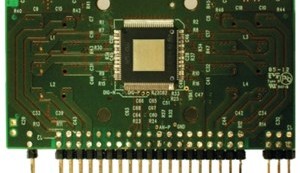Four channels at 28W
January 07, 2016
on
on

Time was when audio engineers carefully crafted amplifier circuits using time-honoured analog principles and any frequency greater than 20 kHz appearing in the circuit was a no-no, or at least an unwanted design ‘feature’ that needed to be supressed.
Designing high power amps for vehicles was especially challenging because of the low supply voltage available. That was all before class-D amplifiers became commonplace; now a complete amplifier chip has as many leads and looks no different from a microprocessor chip.
Take the new FDA801 and FDA801B quad D-class amps from STMicroelectronics. Briefly, a single chip supplies four audio channels at 28 W per channel into 4 ohms (50 W max) and can operate into speakers with an impedance as low as 1 ohm. One common (digital I2S) audio input supplies the four amplifiers which operate at a quoted peak efficiency of 93% and a max of 10% THD. Control to the chip is via a I2C bus interface. For more information checkout the STM spec sheet for these devices.
Designing high power amps for vehicles was especially challenging because of the low supply voltage available. That was all before class-D amplifiers became commonplace; now a complete amplifier chip has as many leads and looks no different from a microprocessor chip.
Take the new FDA801 and FDA801B quad D-class amps from STMicroelectronics. Briefly, a single chip supplies four audio channels at 28 W per channel into 4 ohms (50 W max) and can operate into speakers with an impedance as low as 1 ohm. One common (digital I2S) audio input supplies the four amplifiers which operate at a quoted peak efficiency of 93% and a max of 10% THD. Control to the chip is via a I2C bus interface. For more information checkout the STM spec sheet for these devices.
Read full article
Hide full article



Discussion (0 comments)